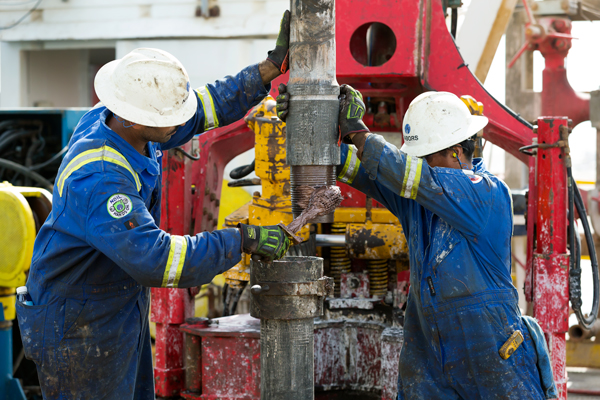When most people picture drilling for oil, they typically conjure images of roughnecks risking life and limb, wrestling heavy chains and enormous pieces of equipment. Even though scenes like those are often scripted dramatically into movies and television shows, Chris Magnuson, vice president of research and development at Nabors—one of the world’s largest oil and gas drilling contractors—says that the industry has moved well beyond those manual operations that originated more than 150 years ago.
“You can still find manual rigs, but very few companies drill like that anymore,” Magnuson says. In fact, he’s leading the initiative at Nabors to develop highly automated land-based drilling platforms that are safer and more efficient and productive.

The effort began in 2013 when Nabors chairman and chief executive officer Anthony Petrello challenged the company to create a hands-free land rig and offshore drill floor that would remove personnel from hazardous areas, where dropped objects and pipe handling are among the most common causes of accidents. That challenge set Magnuson on a process of reviewing all rig equipment and operations to assess for potential automation. This occurred during an economic downturn when most drilling contractors were reducing costs, not investing in R&D.
Magnuson’s efforts were complicated by the fact that land drilling rigs have a much smaller footprint to work with than offshore platforms. Mobile offshore drilling units are self-contained systems that contain all the needed equipment and are designed for ease of mobility. Land rigs must be disassembled and reassembled to be moved.
Additionally, compressed schedules can require land rigs to move to new locations after less than four weeks on-site and be able to handle the stress and strain of rig-down, transportation, and rig-up operations that can last anywhere from three to ten days.
“Our challenge was to come up with cost-effective, safety-focused, automated equipment that could be integrated seamlessly into an existing rig,” Magnuson says. “We still had to provide a comprehensive platform of services and enhance and optimize the human effort required to deliver them.”
In addition to being tested successfully, the R&D initiatives secured a portfolio of strategic intellectual property that has yielded eleven patents with numerous applications still in progress.
One representative innovation is the iRacker system, an automatic tubular handling system that weighs each pipe, measures tubular lengths, applies pipe dope (anti-seize material that helps threads rotate and inhibits binding), builds stands offline utilizing the mousehole (an opening in the drill floor used for off-line construction/de-construction of drill pipe stands) and power slips (a hands-free device used to grip the drill string at well center). The system allows all operations to be controlled from inside the driller’s cabin. Its patented automated parking system allows the pipe handling system to be moved offline so the rig crew can address problems, or position other large pieces of equipment on the rig floor. With the same specification as an offshore pipe handler, the iRacker system requires just one-quarter of the footprint and still meets the rigorous rig-up and rig-down cyclic loading.
All of these breakthroughs are being tested on commercially active rigs. Magnuson anticipates they will help standardize improved performance, productivity, safety, and efficiency across all of Nabors’ rigs.
“Having this automation online throughout our worldwide network will help push a wide range of metrics to performance levels that are consistently higher than what humans alone can do,” he says.
He’s quick to point out, however, that automation will not put jobs at risk. Instead, it will enable rig personnel to move away from physical labor to higher-level maintenance and technical expertise in electronics, controls, and the equipment itself. “Automation will improve the lives of our crews,” Magnuson says. “If you can do less hazardous, higher-skilled work that’s not done in one hundred-degree heat or sub-freezing winters, then that’s definitely better.”

The physics and engineering education Magnuson received at West Point, coupled with ten years of military experience, played a crucial role in his approach to Nabors’ automation projects. He developed a Skunkworks-type division—modeled after the Lockheed Martin division that was responsible for developing numerous radical breakthroughs in aviation—that tapped existing personnel to design, develop, and create multiple prototypes of the new equipment. The same teams then contributed to expedited learning curves as they transitioned to the field with their creations to oversee implementation and to train other teams on their use.
“Our approach enabled the R&D teams to quickly become subject matter experts and gave them a comprehensive understanding of overall operations,” Magnuson says. “It was very gratifying to see them grow professionally as they developed improved iterations of all the designs, and were ultimately able to see their work all the way through to manufacturing and testing.”
He adds that common practice was to keep parts of failed attempts on the engineers’ and designers’ desks, including his own. It was a tangible way to remind everyone of the lessons learned from well-intentioned failures.
The technical innovations will fit in well with Nabors’ well-established practice of incentivizing crews and personnel to continue learning and expanding their skill sets. Magnuson calls it offering “pathways to progress.”
“When you realize that some jobs require a guy to be nearly ninety feet in the air to help attach a new stand of drill pipe, it’s no surprise that, so far, crews have been very open and supportive of all the new technology that we’re introducing,” he says.
Photos: Courtesy of Nabors
Innovation is at the heart of everything we do at WAGO. From pioneering CAGE CLAMP® connection technology to our range of Interconnect, Interface and Automation solutions, such as the fieldbus independent WAGO-I/O-SYSTEM, our customers count on the performance and reliability of our products to ensure the safe, efficient operation of their systems every time.

